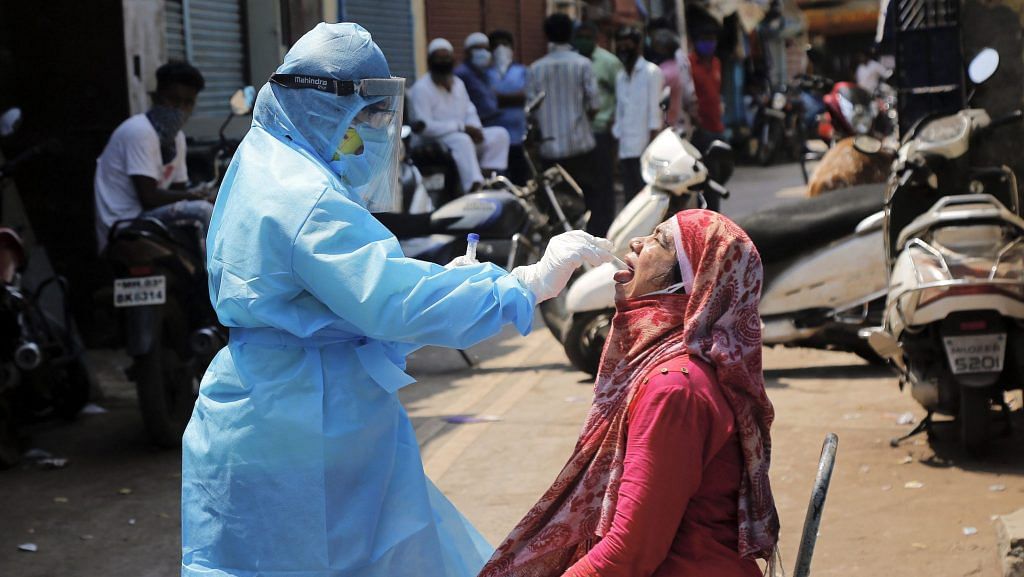New Delhi: Twenty seven days since India went into lockdown, the country’s doubling rate — the time in which the total number of Covid-19 cases double — has improved to 7.5 days, with 18 states doing much better than the national average, the government said Monday.
The health ministry and the Indian Council of Medical Research (ICMR), which conduct daily briefings, also said that 80 per cent of India’s cases are asymptomatic, i.e. individuals do not display any symptoms of the disease.
They also raised concern about the situation in some areas in Maharashtra, Madhya Pradesh, Rajasthan and West Bengal that seem to be “serious”.
Lav Agarwal, the health ministry’s joint secretary, said India’s doubling rate had improved to 7.5 days from 3.4 days before the lockdown, based on data from last week.
The higher this number, the better the situation is since it indicates that not as many new infection cases are being reported daily.
Of the 18 states which reported a higher doubling rate, Delhi, Karnataka, Telangana and Andhra Pradesh have a doubling rate less than 20 days while Haryana, Himachal Pradesh, and Andaman and Nicobar Islands have a doubling rate more than 20 days, said Agarwal.
Two states have a doubling rate of more than 30 days — Odisha’s cases double every 39.8 days while Kerala’s rate is 72.2 days.
In the last 24 hours, India registered 1,553 new cases and 36 deaths, bringing the total confirmed cases to 17,265 with 543 deaths. Till date 1,546 have been cured or discharged, bringing the cure rate to 14.75%, informed Agarwal.
Three new districts did not report any fresh cases in the past 28 days — Mahe in Pondicherry, Kodaggu in Karnataka and Pauri Garhwal in Uttarakhand. These districts will now be categorised as White Zones.
Six districts didn’t record a new case in the past 14 days — Dungarpur and Pali in Rajasthan, Jamnagar and Morbi in Gujarat, North Goa in Goa and Gomati in Tripura.
Also read: Is India’s Covid-19 curve flattening? Cases now double every 10 days, from 3 before lockdown
80% of cases in India asymptomatic
The ICMR, the country’s apex medical research body that has been leading testing of Covid-19 cases in India, said 80 per cent of the cases are asymptomatic, i.e., show no symptoms at the time of testing.
Dr Raman Gangakhedkar, head of infectious diseases at ICMR, said asymptomatic cases are currently being detected when high-risk contacts of confirmed cases are tested. There seems to be no other way to detect more asymptomatic cases, the epidemiologist added.
Agarwal said that the asymptomatic are in most instances mild cases. According to the World Health Organization, going by the the global average, 14 per cent of Covid-19 cases suffer from severe symptoms, of which only 5 per cent require critical care.
On whether India needs to revise its testing strategy, Gangakhedkar said that the Real Time Polymerase chain reaction (RT-PCR) tests, which are currently being used as confirmatory tests, can detect the infection more accurately when an individual develops symptoms.
Given this fact, revising the testing guidelines would not be very cost-effectiveness, he said, adding that screening influenza-like illness cases in hotspots is the most that can be done at the moment.
Also read: Asymptomatic coronavirus patients in Delhi to be kept in Covid care centres
Four states in the red
The situation in some parts of Maharashtra, Madhya Pradesh, West Bengal and Rajasthan has been getting serious, said Punya Salila Srivastava, joint secretary, Ministry of Home Affairs.
These areas include Pune and Mumbai in Maharashtra, Jaipur in Rajasthan, Indore in Madhya Pradesh, Kolkata, Howrah, North 24 Parganas, Midnapore East, Darjeeling and Kalimpong in West Bengal.
To monitor the situation on the ground, the central government has formed six teams under the National Disaster Management Act who have already reached the states, Srivastava said.
The teams are being led by additional secretary-level officers and include a senior public health specialist and a senior member from National Disaster Management Authority.
The teams will focus on the hotspot areas, monitor the health infrastructure and provide health, administrative and other logistical support to the states.
Also read: Before lockdown relaxation, states confused over Centre’s Red, Green, Orange classifications
